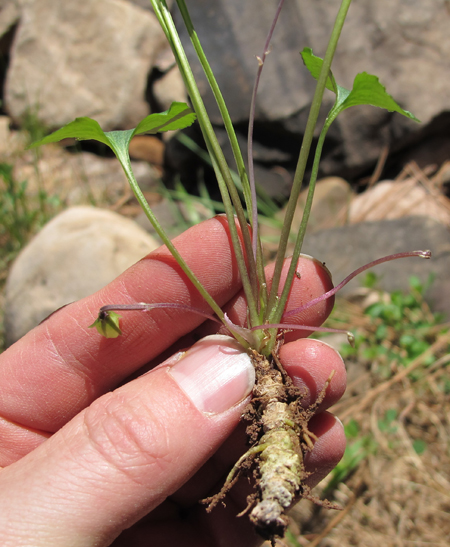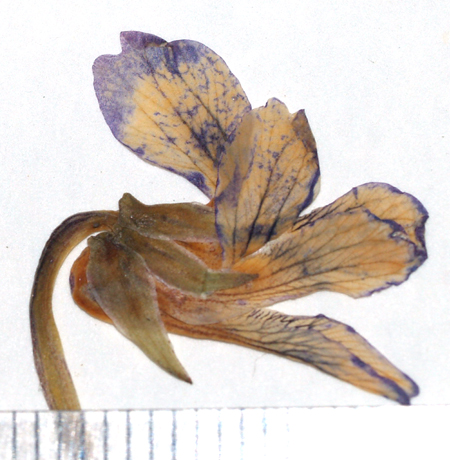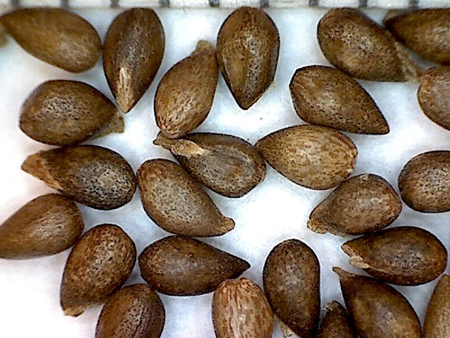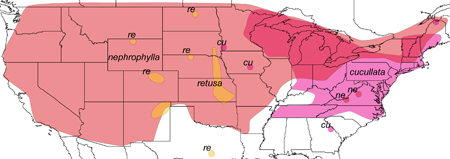Viola retusa Greene
Common names:
Great Plains Riverside Violet
Synonyms:
Viola retusa Greene, Pittonia 4: 6. 1899. TYPE: USA, Colorado, Fort Collins, 5000 feet, 2 May 1896, C. F. Baker s.n. (LECTOTYPE: designated by Ballard et al. 2020. Journal of the Botanical Research Institute of Texas 14(2): 225): NDG033232; ISOLECTOTYPES: NY00097585, NY00097586; internet images!).
Description:
Acaulescent rosulate perennials from thick rhizome, ≤ 15 cm tall; foliage and calyces green, peduncles tinged or finely spotted with reddish-purple, foliage and peduncles strictly glabrous; stipules free, irregularly glandular-fimbriate; leaves spreading, leaf blades undivided, largest ≤ 55 × 40 mm, ovate- to deltate-triangular, as broad as long (rarely with the largest leaf longer than broad), base cordate, apex acuminate to acute, broadening in fruit to broadly deltate-triangular or deltate-reniform, base subtruncate to shallowly cordate, apex abruptly acute, margins crenate to crenate-serrate, eciliate; chasmogamous peduncle held mostly among the leaves or occasionally above them in early flower; chasmogamous flower ≤ 28 mm; calyx glabrous, eciliate; lowest sepals linear-lanceolate to lance-triangular, acuminate; auricles promiment and erose (rarely short and entire), weakly elongating in fruit to 1.5(–2) mm; corolla blue to purple, throat white; spur short-globose; lateral petals densely bearded with filiform hairs, spurred petal densely bearded; upper petals commonly retuse; cleistogamous flowers produced after chasmogamous, on declined or ascending peduncle that soon becomes erect and are slightly shorter than or equalling the petioles; capsule 5–10 mm, green drying to tan, unspotted, glabrous; seeds 1.7–2.2 × 1.0–1.3 mm, medium brown with minute raised black spots.
Similar species:
This species is most similar to other Borealiamericanae violets with leaves longer than broad in chasmogamous flower that broaden to as broad as long in fruit, namely Viola affinis, Viola cucullata, Viola impostor, Viola langloisii, Viola missouriensis, and V. pratincola; it has also been confused with V. nephrophylla, which is regionally sympatric with this species and occasionally grows near it. In chasmogamous flower it differs from all of the above in the slender commonly retuse upper petals, from Viola cucullata, Viola impostor, Viola langloisii and Viola missouriensis in its densely bearded spurred petal, additionally from V. cucullata by its lateral petal beards with long filiform hairs and from Viola missouriensis in its narrower long-acuminate eciliate sepals; from V. affinis in its strictly glabrous foliage and peduncle, and prominent auricles; and from V. pratincola in its more slender long-acuminate sepals and more densely spurred petal. In cleistogamous fruit it can be distinguished from Viola affinis and Viola missouriensis by its unspotted cleistogamous capsule on an eventually erect peduncle, and medium brown spotted seeds; from Viola cucullata and V. impostor by its shorter auricles and spotted seeds; from V. langloisii by its erect leaves, erect cleistogamous peduncle, and medium brown spotted seeds; from V. nephrophylla but its strictly glabrous foliage, leaf blades with abruptly acute to acuminate apex, slender long-acuminate sepals, prominent auricles, and larger spotted seeds; and from V. pratincola from leaf blades with more prolonged apex, and more slender long-acuminate sepals.
Ecology:
Gravel alluvium and riparian zones, sometimes under open woods bordering riverbanks.
Distribution:
Great Plains; n. ND to n. WY, south to e. KS, c. TX, ne. NM, and n.-c. CO; sporadic eastward into IA and MN.
Rarity:
None.
Phenology:
Chasmogamous flower April–May, chasmogamous fruit April–July, cleistogamous fruit May–October.
Affinities:
This species belongs to the Acaulescent Blue Violet lineage, sect. Nosphinium W.Becker, subsect. Boreali-Americanae (W.Becker) Gil-ad, in the Cucullata species group.
Hybrids:
None.
Comments:
Greene wrote &uot;Plains of northern Colorado, toward the foothills; the best specimens from Carl F. Baker, collected at Fort Collins, 2 May, 1896, and named by me V. cognata at the time...." He cited one collection but did not identify one sheet or designate it as a type, and mentioned no particular herbarium. The JSTOR Global Plants database has images of three sheets matching the protologue, with mostly the same information. The NDG033232 sheet has the original identification of “Viola cucullata Gray” and the subsequent identification of “Viola cognata” above it both struck out and replaced by “retusa,” possibly in Greene’s hand, while the two NY sheets still retain the original identification of “Viola cucullata Gray.” The NDG sheet has the most luxuriant chasmogamous flowering specimens that best represent the taxon, and it was selected as lectotype by Ballard et al. (2020).
This violet of gravel and sand alluvium along streams and rivers in the Great Plains was described by Greene in 1899 and immediately passed into obscurity. It was momentarily resurrected by Brainerd (1913d) in his Violaceae treatment in Britton and Brown's "Illustrated Flora", then again inexplicably dropped from Brainerd's own violet opus (Brainerd 1921b)–to the present time. The lack of mention of the name, considering its publicity in the 1913 treatment, is bizarre. Nevertheless, Ross McCauley and I have confirmed it as a morphologically distinct and very uniform species well represented by a substantial number of chasmogamous flowering and cleistogamous fruiting herbarium specimens, inhabiting an ecologically distinctive riparian border niche across the Great Plains region and eastward sporadically into Iowa and Minnesota. Specimens with well-formed chasmogamous and cleistogamous capsules full of apparently viable seeds provide further evidence that it is not a de novo hybrid. It is accepted here as a distinct but wholly overlooked species. Russell's (1965) distribution maps and annotations on herbarium specimens indicate that he included most specimens in V. pratincola and the small remainder in V. missouriensis or V. nephrophylla. The violet is surely more common in the Great Plains than the scattered herbarium collections suggest; searches should concentrate on the characteristic riparian border habitat. Ross McCauley (pers. comm.) recently found it in northeastern New Mexico and included it in the forthcoming Violaceae treatment for the new flora of that state.
Literature Cited:
Ballard Jr., H. E., R. N. Burwell, and S. L. Lockhart. 2020. Violaceae: Typifications and clarifications of names. In Weakley, A. S., D. B. Poindexter, H. C. Medford, B. A. Sorrie, C. A. McCormick, E. L. Bridges, S. L. Orzell, K. A. Bradley, H. E. Ballard, Jr., R. N. Burwell, S. L. Lockhart, and A. R. Franck. Studies in the vascular flora of the southeastern United States. VI. Journal of the Botanical Research Institute of Texas 14(2): 217-229.
Brainerd, E. 1913d. Viola. In Britton, N. L. and A. Brown, An illustrated flora of the northern United States, Canada and the British possessions. C. Scribner's sons, New York, NY, 545-563.
Brainerd, E. 1921b. Violets of North America. Vermont Agricultural Experiment Station Bulletin 224: 1-172.

Chasmogamous flowering habit from herbarium specimen: KS, Wilson Co., 2 mi. W. Fredonia, Low, roadside right of way, Moist, rich soil, 21 Apr 1969, S. Stephens 30040 (NY)

Cleistogamous fruiting habit by Ross McCauley

Rhizome and cleistogamous fruit by Ross McCauley

Chasmogamous flower profile view from herbarium specimen: KS, Wilson Co., 2 mi. W. Fredonia, Low, roadside right of way, Moist, rich soil, 21 Apr 1969, S. Stephens 30040 (NY)

Cleistogamous fruit by Ross McCauley

Seeds from herbarium specimen: CO, New Windsor, [donor] G. E. Osterhout, 1905, [cultivated at NYBG nursery then later collected by] W. W. Eggleston and R. L. Schneider 22927 (NY)

Seeds from herbarium specimen: NE, Near Fremont, Alt. 300 M., Moist ground, 5 Jun 1901, D. T. MacDougal 12 (NY)

Map of Cucullata species group by Harvey Ballard (Canadian collections have not been consulted for these taxa)